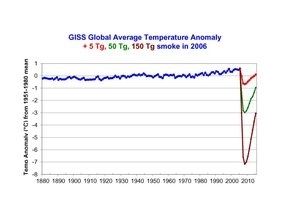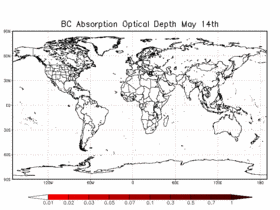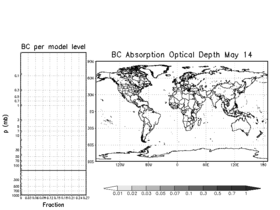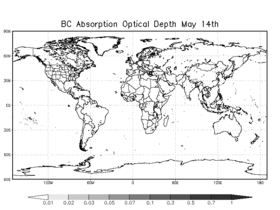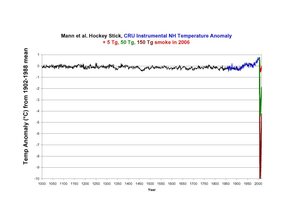Nuclear winter (About the EoE)
Contents
- 1 Nuclear winter
- 1.1 Introduction Nuclear winter is a term that describes the climatic effects of nuclear war. In the 1980's, work conducted jointly by Western and Soviet scientists showed that for a full-scale nuclear war between the United States and the Soviet Union the climatic consequences, and indirect effects of the collapse of society, would be so severe that the ensuing nuclear winter would produce famine for billions of people far from the target zones. There are several wrong impressions that people have about nuclear winter. One is that there was a flaw in the theory and that the large climatic effects were disproven. Another is that the problem, even if it existed, has been solved by the end of the nuclear arms race. But these are both wrong. Furthermore, new nuclear states threaten global climate change (Nuclear winter) even with arsenals that are much less than 1% of the current global arsenal.
- 1.2 What's New
- 1.3 How Does Nuclear Winter Work?
- 1.4 Analogs Support the Theory
- 1.5 Policy Implications
- 1.6 Note
- 1.7 Footnotes
- 1.8 References
Nuclear winter
Introduction Nuclear winter is a term that describes the climatic effects of nuclear war. In the 1980's, work conducted jointly by Western and Soviet scientists showed that for a full-scale nuclear war between the United States and the Soviet Union the climatic consequences, and indirect effects of the collapse of society, would be so severe that the ensuing nuclear winter would produce famine for billions of people far from the target zones. There are several wrong impressions that people have about nuclear winter. One is that there was a flaw in the theory and that the large climatic effects were disproven. Another is that the problem, even if it existed, has been solved by the end of the nuclear arms race. But these are both wrong. Furthermore, new nuclear states threaten global climate change (Nuclear winter) even with arsenals that are much less than 1% of the current global arsenal.
What's New
Based on new work published in 2007 and 2008 by some of the pioneers of nuclear winter research who worked on the original studies, we now can say several things about this topic.
New Science:
- A minor nuclear war (such as between India and Pakistan or in the Middle East), with each country using 50 Hiroshima-sized atom bombs as airbursts on urban areas, could produce climate change unprecedented in recorded human history. This is only 0.03% of the explosive power of the current global arsenal.
- This same scenario would produce global ozone depletion, because the heating of the stratosphere would enhance the chemical reactions that destroy ozone.
- A nuclear war between the United States and Russia today could produce nuclear winter, with temperatures plunging below freezing in the summer in major agricultural regions, threatening the food supply for most of the planet.
- The climatic effects of the smoke from burning cities and industrial areas would last for several years, much longer than we previously thought. New climate model simulations, that have the capability of including the entire atmosphere and oceans, show that the smoke would be lofted by solar heating to the upper stratosphere, where it would remain for years.
New Policy Implications:
- The only way to eliminate the possibility of this climatic catastrophe is to eliminate the nuclear weapons. If they exist, they can be used.
- The spread of nuclear weapons to new emerging states threatens not only the people of those countries, but the entire planet.
- Rapid reduction of the American and Russian nuclear arsenals will set an example for the rest of the world that nuclear weapons cannot be used and are not needed.
How Does Nuclear Winter Work?
A nuclear explosion is like bringing a piece of the Sun to the Earth's surface for a fraction of a second. Like a giant match, it causes cities and industrial areas to burn. Megacities have developed in India and Pakistan and other developing countries, providing tremendous amounts of fuel for potential fires. The direct effects of the nuclear weapons, blast, radioactivity, fires, and extensive pollution, would kill millions of people, but only those near the targets. However, the fires would have another effect. The massive amounts of dark smoke from the fires would be lofted into the upper troposphere, 10-15 kilometers (6-9 miles) above the Earth's surface, and then absorption of sunlight (Solar radiation) would further heat the smoke, lifting it into the stratosphere, a layer where the smoke would persist for years, with no rain to wash it out.
The climatic effects of smoke from fires started by nuclear war depend on the amount of smoke. Our new calculations show that for 50 nuclear weapons dropped on two countries, on the targets that would produce the maximum amount of smoke, about 5 megatons (Tg) of black smoke would be produced, accounting for the amount emitted from the fires and the amount immediately washed out in rain. As the smoke is lofted into the stratosphere, it would be transported around the world by the prevailing winds. We also did calculations for two scenarios of war between the two superpowers who still maintain large nuclear arsenals, the United States and Russia. In one scenario, 50 Tg of black smoke would be produced and in another, 150 Tg of black smoke would be produced. How many nuclear weapons would be required to produce this much smoke? It depends on the targets, but there are enough weapons in the current arsenals to produce either amount. In fact, there are only so many targets. Once they are all hit by weapons, additional weapons would not produce much more smoke at all. Even after the current nuclear weapons reduction treaty between these superpowers is played out in 2012, with each having about 2,000 weapons, 150 Tg of smoke could still be produced.
Here are movies of the smoke transport from three different scenarios:
These new results were made possible by the use of a state-of-the-art general circulation model of the climate. For the first time a complete calculation of not only atmospheric (Global-scale circulation of the atmosphere) but also oceanic circulation was conducted, including the entire atmosphere (Atmosphere layers) from the surface up through the troposphere, stratosphere, and mesosphere, to an elevation of 80 kilometers (50 miles). Previous calculations had not been run for the 10 year simulations here, and had not allowed the smoke to be lofted into the upper stratosphere, where it would persist for many years.
We calculated the climate response to the three scenarios illustrated above. Compared to the global warming observed for the past century, all three scenarios show massive cooling. Compared to the climate change for the Northern Hemisphere for the past 1,000 years, the famous hockey stick diagram, the climate change from any of these scenarios is unprecedented. Compared to climate change for the past millenium, even the 5 Tg case (a war between India and Pakistan) would plunge the planet into temperatures colder than the Little Ice Age (approximately 1600-1850). This would be essentially instantly, and agriculture would be severely threatened. Larger amounts of smoke would produce larger climate changes, and for the 150 Tg case produce a true nuclear winter, making agriculture impossible for years. In both cases, new climate model simulations show that the effects would last for more than a decade.
Analogs Support the Theory
Nuclear winter is a theory based on computer model calculations. Normally, scientists test theories by doing experiments, but we never want to do this experiment in the real world. Thus we look for analogs that can inform us of parts of the theory. And there are many such analogs that convince us that the theory is correct:
- Cities burning. Unfortunately, we have several examples of cities burning, firestorms created by the intense release of energy, and smoke being pumped into the upper atmosphere (Atmosphere layers). These include San Francisco as a result of the earthquake in 1906, and cities bombed in World War II, including Tokyo, Dresden, Hamburg, Darmstadt, Hiroshima, and Nagasaki.
- The seasonal cycle. In the winter, the climate is cooler, because the days are shorter and sunlight is less intense. Again, this helps us quantify the effects of reduction of solar radiation.
- The diurnal cycle. At night the Sun sets and it gets cold at the surface. If the Sun did not rise tomorrow, we already have an intuitive feel for how much cooling would take place and how fast it would cool.
- Volcanic eruptions. Explosive volcanic eruptions, such as those of Tambora in 1815, Krakatau in 1883 and Pinatubo in 1991, provide several lessons. The resulting sulfate aerosol cloud in the stratosphere is transported around the world by winds, thus supporting the results from the animations above. The surface temperature plummets after each large eruption, in proportion to the thickness of the stratospheric cloud. In fact 1816, following Tambora, is known as the "Year Without a Summer," with global cooling and famine. Following the Pinatubo eruption, global precipitation, river flow, and soil moisture all reduced, since cooling the planet by blocking sunlight has a strong effect on reducing evaporation and weakening the hydrologic cycle. This is also what the nuclear winter simulations show.
- Forest fires. Smoke from large forest fires sometimes is injected into the lower stratosphere. And the smoke is transported around the world, also producing cooling under the smoke.
- Dust storms on Mars. Occasionally, dust storms start in one region of Mars, but the dust is heated by the Sun, lofted into the upper atmosphere, and transported around the planet to completely enshroud it in a dust blanket. This process takes a couple weeks, just like our computer simulations for the nuclear winter smoke.
- Extinction of the dinosaurs. 65,000,000 years ago an asteroid or comet smashed into the Earth in southern Mexico. The resulting dust cloud, mixed with smoke from fires, blocked out the Sun, killing the dinosaurs, and starting the age of mammals. This Cretaceous-Tertiary (K-T) extinction may have been exacerbated by massive volcanism in India at the same time. This teaches us that large amounts of aerosols in Earth's atmosphere have caused massive climate change and extinction of species. The difference with nuclear winter is that the K-T extinction could not have been prevented.
Policy Implications
The work on nuclear winter in the 1980's, and the realization that both direct and indirect effects of nuclear war would be a global catastrophe, led to the end of arms race and the end of the Cold War. In response to the comment "In the 1980s, you warned about the unprecedented dangers of nuclear weapons and took very daring steps to reverse the arms race," in an interview in 2000, Mikhail Gorbachev said "Models made by Russian and American scientists showed that a nuclear war would result in a nuclear winter that would be extremely destructive to all life on Earth; the knowledge of that was a great stimulus to us, to people of honor and morality, to act in that situation."[1]
Since the 1980's, the number of nuclear weapons in the world has decreased to 1/3 of the peak number of more than 70,000. The consequences of regional-scale nuclear conflicts are unexpectedly large, with the potential to become global catastrophes. The combination of nuclear proliferation, political instability, and urban demographics may constitute one of the greatest dangers to the stability of society since the dawn of humans. The current and projected American and Russian nuclear arsenals can still produce nuclear winter. Only nuclear disarmament will prevent the possibility of a nuclear environmental catastrophe.
Note
Copies of all the papers that describe these results, with figures, slide shows, and animations are available for free download at http://climate.envsci.rutgers.edu/nuclear
Footnotes
References
References to Our New Work
- Mills, Michael J., Owen B. Toon, Richard P. Turco, Douglas E. Kinnison, and Rolando R. Garcia, 2008: Massive global ozone loss predicted following regional nuclear conflict. Proc. National Acad. Sci., 105, 5307-5312.
- Robock, Alan, Luke Oman, Georgiy L. Stenchikov, Owen B. Toon, Charles Bardeen, and Richard P. Turco, 2007a: Climatic consequences of regional nuclear conflicts. Atm. Chem. Phys., 7, 2003-2012.
- Robock, Alan, Luke Oman, and Georgiy L. Stenchikov, 2007b: Nuclear winter revisited with a modern climate model and current nuclear arsenals: Still catastrophic consequences. J. Geophys. Res., 112, D13107, doi:2006JD008235.
- Robock, Alan, Owen B. Toon, Richard P. Turco, Luke Oman, Georgiy L. Stenchikov, and Charles Bardeen, 2007c: The continuing environmental threat of nuclear weapons: Integrated policy responses needed. EOS, 88, 228, 231, doi:10.1029/2007ES001816.
- Robock, Alan, 2007: Climate effects of a regional nuclear conflict. IPRC Climate, 7, no. 1, 16-18.
- Robock, Alan, 2008: Time to bury a dangerous legacy: Part II: Climatic catastrophe would follow regional nuclear conflict. YaleGlobal Online.
- Toon, Owen B., Richard P. Turco, Alan Robock, Charles Bardeen, Luke Oman, and Georgiy L. Stenchikov, 2007a: Atmospheric effects and societal consequences of regional scale nuclear conflicts and acts of individual nuclear terrorism. Atm. Chem. Phys., 7, 1973-2002.
- Toon, Owen B., Alan Robock, Richard P. Turco, Charles Bardeen, Luke Oman, and Georgiy L. Stenchikov, 2007b: Consequences of regional-scale nuclear conflicts. Science, 315, 1224-1225.
References to Classical Original Articles on Nuclear Winter
- Aleksandrov, V. V., and G. L. Stenchikov, 1983: On the modeling of the climatic consequences of the nuclear war, Proc. Applied Math, Computing Centre, USSR Academy of Sciences, Moscow, 21 pp.
- Crutzen, P. J., and J. W. Birks, 1982: The atmosphere after a nuclear war: Twilight at noon, Ambio, 11, 114-125.
- Harwell, M. A. and T. C. Hutchinson, Eds., 1986: Environmental Consequences of Nuclear War, SCOPE 28. Volume II, Ecological and Agricultural Effects, John Wiley & Sons, New York.
- Mann, M. E., R. S. Bradley, and M. K. Hughes, 1999: Northern Hemisphere temperatures during the past millennium: Inferences, uncertainties, and limitations, Geophys. Res. Lett., 26, 759-762.
- Pittock, A. B., T. P. Ackerman, P. J. Crutzen, M. C. MacCracken, C. S. Shapiro, and R. P. Turco, Eds., 1986: Environmental Consequences of Nuclear War, SCOPE 28. Volume I, Physical and Atmospheric Effects, John Wiley & Sons, New York.
- Robock, A., 1984: Snow and ice feedbacks prolong effects of nuclear winter, Nature, 310, 667-670.
- Robock, A., 1989: Policy implications of nuclear winter and ideas for solutions, Ambio, 18, 360-366.
- Sagan, C., and R. Turco, 1990: A Path Where No Man Thought - Nuclear Winter and the End of the Arms Race, New York, Random House, 499 pp. ISBN: 0394583078.
- Turco, R. P., O. B. Toon, T. P. Ackerman, J. B. Pollack, and C. Sagan, 1983: Nuclear winter: Global consequences of multiple nuclear explosions, Science, 222, 1283-1292.
- Turco, R. P., O. B. Toon, T. P. Ackerman, J. B. Pollack, and C. Sagan, 1990: Climate and smoke: An appraisal of nuclear winter, Science, 247, 166-176.
